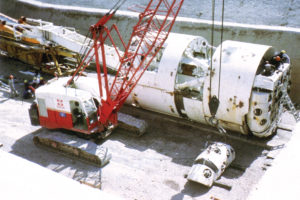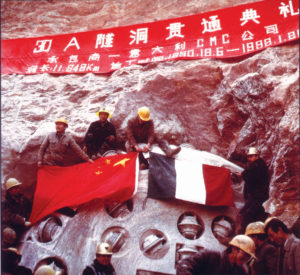![65 Years of Innovation and Experience [default]](https://www.robbinstbm.com/wp-content/uploads/2017/04/Side-Bar-Blue-Blocks_70-Years.jpg)
A Solution for Every Condition: Search our Project Database
Project Map
FEATURED PRODUCT: CROSSOVER MACHINES
Our History
A Legacy of Innovation
Information 24/7
News & Media
Insights in the Industry:
Read the Robbins Blog
 The Yindaruqin Irrigation Project is the largest self-flowing irrigation control system in China. The project is made up of 33 tunnels that are 75 km (46.6 mi) in length and divert water from the Datong River to dry regions of China’s northern Gansu Province.
The Yindaruqin Irrigation Project is the largest self-flowing irrigation control system in China. The project is made up of 33 tunnels that are 75 km (46.6 mi) in length and divert water from the Datong River to dry regions of China’s northern Gansu Province.
In 1990 the Gansu Province Resources Bureau awarded the contract for the project to Cooperative Muratori and Cementisti (CMC) of Ravenna, Italy. CMC chose a 5.5 m (18.0 ft) diameter Robbins Double Shield TBM for the first two drives of the multi-tunnel project.
Rock formations along the first tunnel, 30A, consist mostly of tertiary sediments and gently dipping conglomerate with drift block and sandy conglomerate. Precambrian crystalline limestone with slate occurs at the tunnel inlet and Quaternary sediments make up the outlet area. Other geologic features of the 30A site include 23 main faults in the limestone section and large karst caves.
The second tunnel, 38, passes through moderately dipping beds of Cretaceous sedimentary rocks, mostly sandstone.
Robbins built the Double Shield TBM with 37 back-loading 17 inch (432 mm) diameter disc cutters. Six electric motors generated 960 kW (1,287 hp) of power and supplied 3,065 kNm (2,368,000 lb-ft) of torque.
The TBM design included a telescoping section with 12 thrust cylinders behind the cutterhead. These cylinders provided roll control without the need for additional torque cylinders because they were installed at alternating angles between the gripper and forward shield. The arrangement allowed efficient vertical and lateral steering of the cutterhead and forward shield.
The TBM’s rear section housed the grippers and eight auxiliary thrust cylinders. Additional features of the TBM included a two-speed drive, a laser guidance system, hydraulic clutches, stand-by hydraulic pumps and oil filters.
Air compressors on the TBM’s 150 m (492 ft) long back-up train eliminated the need for an air line along the length of the excavation. A 1400 mm (55 in) diameter ventilation duct provided fresh air to the work area and an air scrubber extracts dust from the tunnel.
The back-up system included a single-track trailing gantry followed by a movable California switch. Additional fixed crossings occured at intervals of about 3,500 m (11,483 ft), depending on the average speed of empty and loaded muck cars.
The Robbins Double Shield TBM design allowed the tunnel lining to be installed simultaneously with excavation. The tunnel lining consisted of reinforced concrete segments mechanically erected from within the tail shield as the machine advanced. Each ring’s four segments fit together in a self-locking design, with the rounded lip of one curved segment overlapping that of the neighboring segments. A honeycomb pattern in the finished tunnel lining resulted from the staggered arrangement of segments within the rings. Each 300 mm (11.8 in) hexagonal segment was 1.6 m (5.2 ft) wide, a size that minimized the required number of rings. This feature contributed substantially to the superior advance rate of the TBM.
 The TBM exhibited impressive advance rates — even breaking the world record for average monthly production for TBMs 5 to 6 m (16.4 to 19.7 ft) in diameter. The TBM began boring the 11.7 km (7.3 mi) tunnel 30A on January 9, 1991. The machine bored 780 m (2,559 ft) in the first 22 days and finished five months ahead of schedule. Its average daily advance was 36.09 m (118.4 ft), and its average penetration rate was 4.99 m (16.4 ft) per hour. July 1991 was the machine’s best working month with a total advance of 1,301 m (4,268 ft).
The TBM exhibited impressive advance rates — even breaking the world record for average monthly production for TBMs 5 to 6 m (16.4 to 19.7 ft) in diameter. The TBM began boring the 11.7 km (7.3 mi) tunnel 30A on January 9, 1991. The machine bored 780 m (2,559 ft) in the first 22 days and finished five months ahead of schedule. Its average daily advance was 36.09 m (118.4 ft), and its average penetration rate was 4.99 m (16.4 ft) per hour. July 1991 was the machine’s best working month with a total advance of 1,301 m (4,268 ft).
The success of the TBM is remarkable considering the troublesome geology of the tunnel. About 2,300 m (7,545 ft) into the drive, sticky argillaceous conglomerate caused clogging of the muck buckets, chute, hopper and cutter housings. Also, the machine encountered 60 to 150 liter (15.9 to 39.6 gallon) per second water inrushes in fractured calcareous rock around 9,000 m (29,527 ft) into the tunnel. The TBM advance slowed through this section but quickly recovered for the rest of the excavation.
On January 20, 1992, the machine holed through the first tunnel. Work on the second 4.9 km (3.0 mi) tunnel began in April 1992 and finished in August of the same year. In June 1992, the TBM set a world record for 5-6 m (16.4 ft – 19.6 ft) diameter class TBMs when it excavated 1,401.6 m (4,598.4 ft) in one month. Its average daily advance was 40.67 m (133.4 ft), with a maximum of 75.2 m (246.7 ft) on May 11. The TBM’s overall rate of advance was 4.01 m (13.2 ft) per hour.
The machine completed its second tunnel in 120 working days. The original bid specifications for Yindaruqin’s first two tunnels included a 54-month excavation time limit. Both projects were completed in 20 months, less than half the allotted time.

 Close
Close